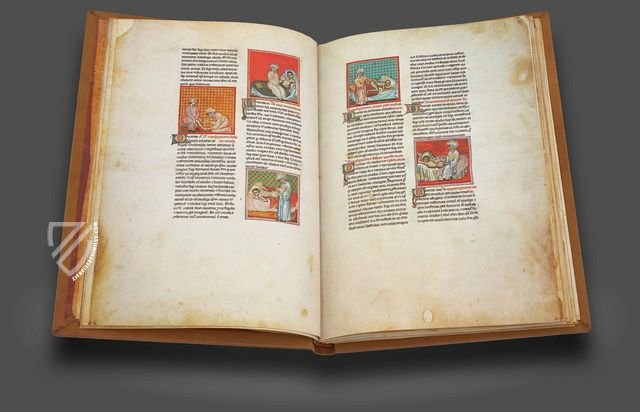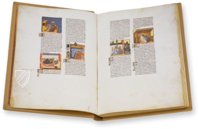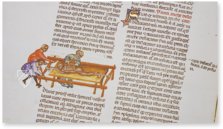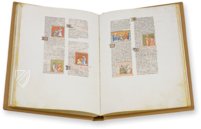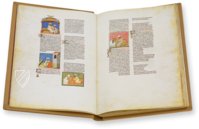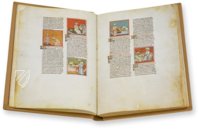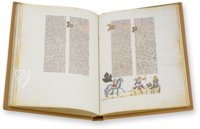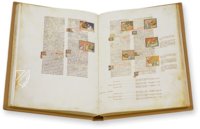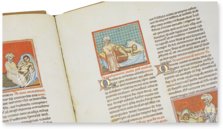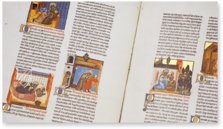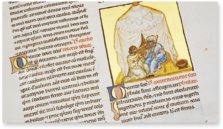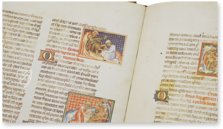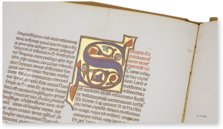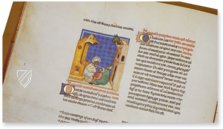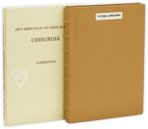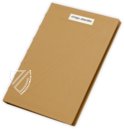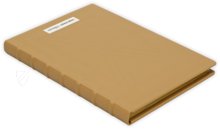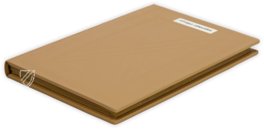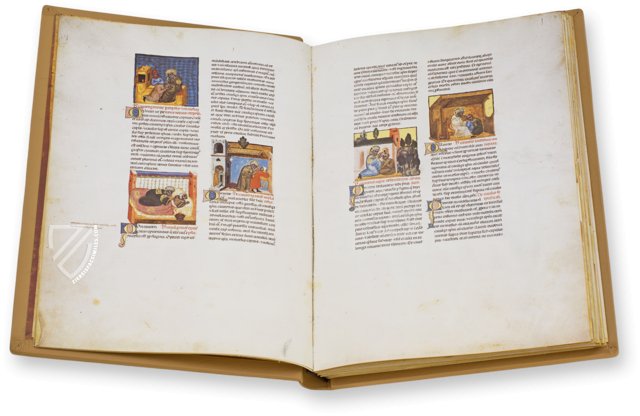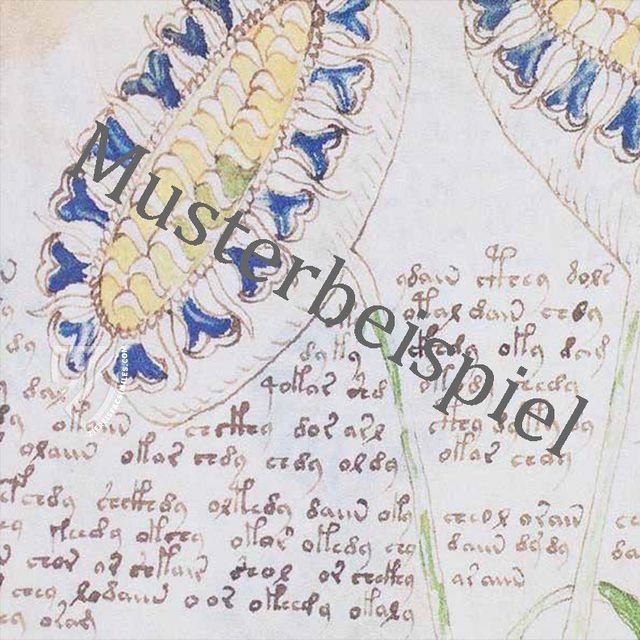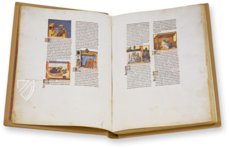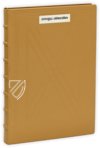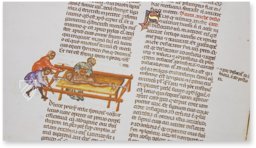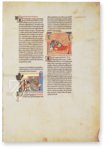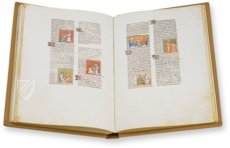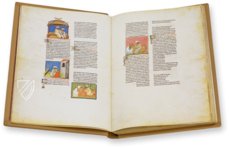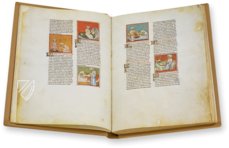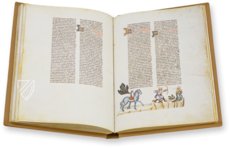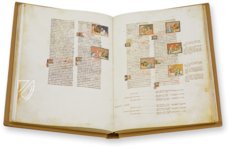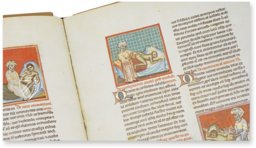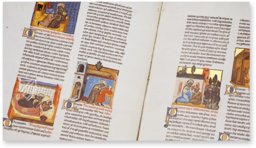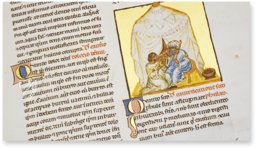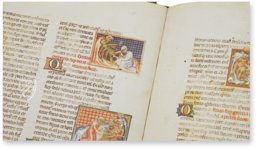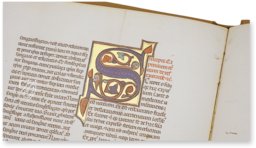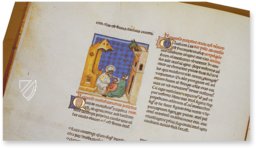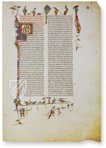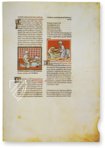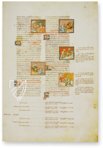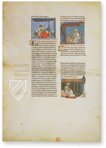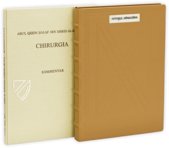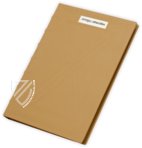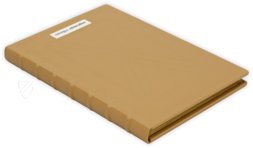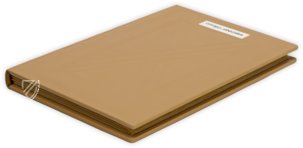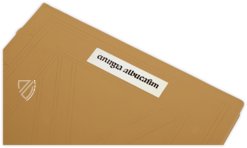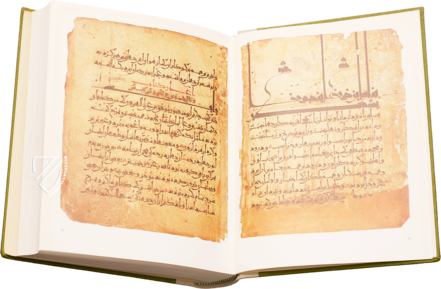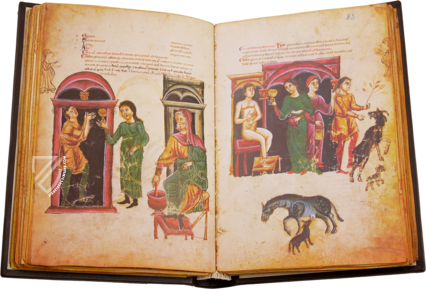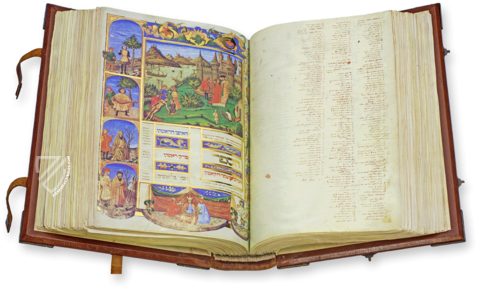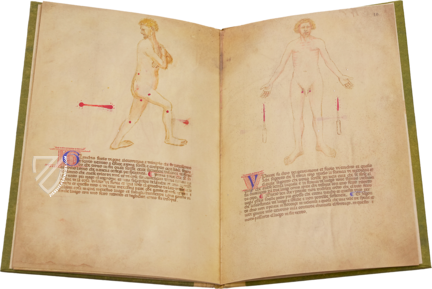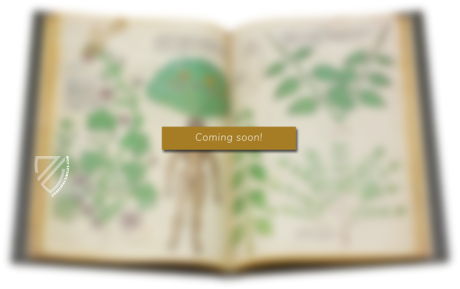Abu´l Qasim Halaf ibn Abbas al-Zahraui – Chirurgia
(1,000€ - 3,000€)
A textbook on surgery with over 500 years of validity: The Arab physician Abu´l Qasim Halaf ibn Abbas al-Zahraui (936–1013) wrote a standard work of epoch-making effect. The Chirurgia is the oldest and also most important link between Greek classical and late classical medicine and the European medicine of the high Middle Ages. In it, the personal physician to Caliph al-Hakam II (961–976) combines the medical knowledge of antiquity with the physician´s own experience from decades of medical practice. The text was translated from Arabic into Latin by Gerard of Cremona (1114–1187), at which point Latin Europe was given the opportunity of access to a text which combined European medical knowledge in the field of surgery with highly specialized Greek and Arab findings. Furthermore, this Latin manuscript is illustrated with 68 gold-decorated and richly detailed miniatures, which probably go back to Arabic models. It presents different medical disciplines and also makes accessible the therapeutic practices of the time. A significant work for the history of medicine as well as art history and extremely charming.
Abu´l Qasim Halaf ibn Abbas al-Zahraui – Chirurgia
The textbook of surgery written by the Arab physician Abu al-Qasim Khalaf Ibn Abbas az-Zahrawi stood for nearly 500 years as the leading handbook in this field of medicine. It constitutes the oldest and also most important link between Greek classical and late classical medicine and the European medicine of the high Middle Ages. Over long stretches of the Middle Ages, the Occident had lost the medical knowledge of Greco-Roman classical teachings. The Arabs, who preserved the classical ideas in the domains of poetry, philosophy, and science, brought this knowledge back to the western world, especially in the field of surgery where Arab medicine had made great progress. The most famous representative in this field was Abu al-Qasim, court physician of the Western Umayyad Caliph al-Hakam II (961–976) and author of writings which later became widely known. The Latin translation of this Arabic textbook on surgery was richly illustrated and lavishly decorated, thus underlining the estimation of the western world for what was then this most sensational of texts. In all, 68 miniatures form the artistic furnishings of this bibliophile manuscript, illustrating individual methods of medical treatment and instruments in all their details. Besides these miniatures, which might have been derived from Arab models, numerous 227 gilded initials altogether bear testimony to the flawless quality and great significance of the manuscript, both in medical history and in the history of art.
Abu al-Qasim: a Renowned Arab Physician
Abu al-Qasim is thought to have been born around the 930's or 940's near Cordoba (in al-Zahra precisely). The Arabic scholar thus stemmed from the Western Umayyad Caliphate which reached its climax during the 10th century. As the personal physician to Caliph al-Hakam II, he had the opportunity to enlarge his reputation as a physician, far beyond the scope of his own work. His writings were widely acknowledged and preferred even to the teachings of the Greek medical authority Galen.
The Contents of the Book
Chirurgia is the last chapter of a huge, comprehensive work Kitab al Tasrif liman ajizaan-al-ta´alif comprising the reception of Greek medical knowledge on the one hand and the physician´s own experience from decades of medical practice on the other. Out of 30 chapters of Abu al-Qasim´s lifework, which treats all domains of medicine in an encyclopedic form, only Chirurgia and three more sections were translated into Latin, leaving this huge œuvre widely undisclosed to the western world. Chirurgia, however, went down in high medieval medical history as the most important work in this field. Chirurgia is composed of three books and decorated with numerous miniatures to illustrate diverse methods of treatment. In the first book, which deals with cauterization, 40 miniatures show the application of the glowing iron to different parts of the body. The second book explains incisions, midwifery, bloodletting, the healing of wounds, and the application of leeches and cuppers, all illustrated in 27 miniatures, one of which shows the treatment of hydrocephalus (fol. 17r). The third book on the rejoining of bones and treatment of fractures and dislocated limbs contains the well-known and often reproduced miniature of the rack (fol. 76v).
An Epoch-Making Medical Text
Abu al-Qasim´s Chirurgia was translated from Arabic into Latin by Gerard of Cremona (1114–1187), one of the foremost members of the famous school of translators of Toledo, where numerous Greek writings were transliterated into Latin from Arabic sources. It was through the translation of Chirurgia that Latin Europe was given the opportunity of access to a text which combined European medical knowledge in the field of surgery with highly specialized Greek and Arab findings. A treasure throve not least for Latin philology in the Middle Ages, the Latin version of Chirurgia gave the western world an insight into new and revolutionary methods, thus constituting a truly epoch-making work of medicine.
Codicology
- Alternative Titles
- Abu´l Qasim Halaf ibn Abbas al-Zahraui – Chirurgia
Grundlagenwerk der Medizin und Brücke zwischen Orient und Okzident - Size / Format
- 166 pages / 40.5 × 28.0 cm
- Origin
- Italy
- Date
- 2nd half of the 14th century
- Epochs
- Style
- Language
- Illustrations
- 227 smaller golden initial letters, 1 ornamental page, 1 pen drawing and 68 miniatures with illustrations from the medical sphere; text in Gothic Rotunda
- Artist / School
- Abu al-Qasim (author)
Abu´l Qasim Halaf ibn Abbas al-Zahraui – Chirurgia
Lancing a Boil
Accompanied by an elegant “Q” initial, this Gothic Italian miniature accompanying a text on the lancing of boils is based on an Arabic model. The procedure is about to be performed with the bald, naked patient looking away calmly as he crouches on all fours. Protruding from under the elegant folds of his robe, the doctor’s feet appear to hang out from the frame as though he were about to hop down from the page. Both the bedding and the doctor’s turban are elegantly patterned with gold leaf.
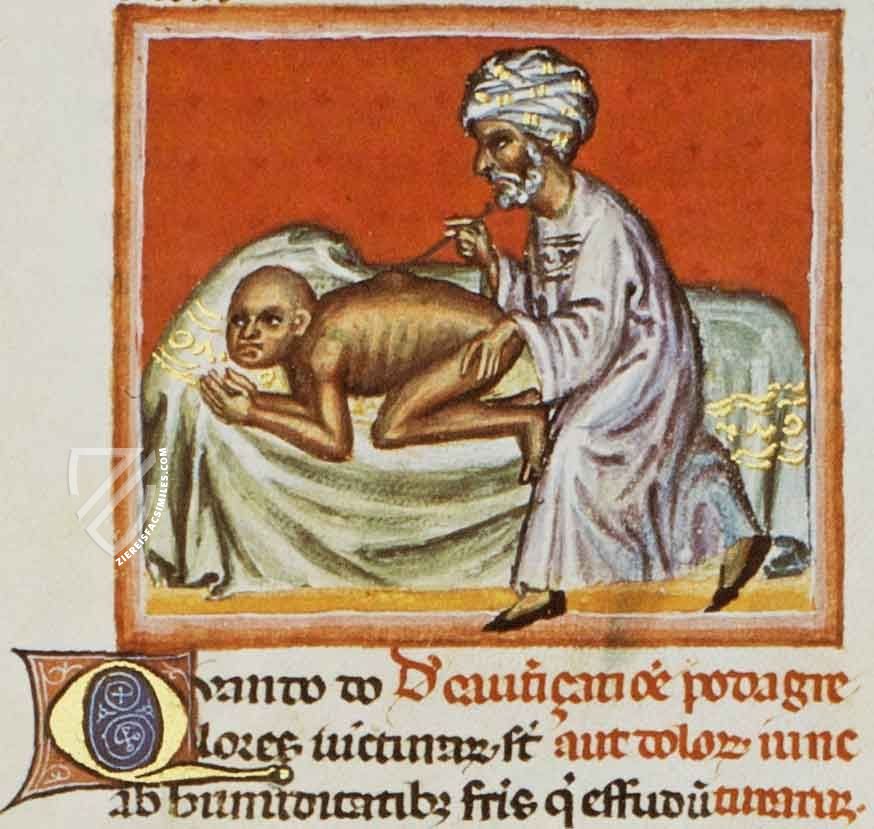
Abu´l Qasim Halaf ibn Abbas al-Zahraui – Chirurgia
Applying the Glowing Iron
The first book of Al-Zahrawi’s influential text on surgery deals with cauterization, which was the Moorish physician’s specialty. The so-called glowing iron is depicted using gold leaf, a nod to his admiration of the technique and its ability to check infection.
Here we see two miniatures imbedded in the text. In both images, the doctor’s status is literally highlighted with gold. On the left, a head wound is being cauterized before an architectural background with a sky of burnished gold. To the right, the patient lies in a lavish bed and has a wound to his chest cauterized while two small figures hold up a curtain behind them – for privacy perhaps?
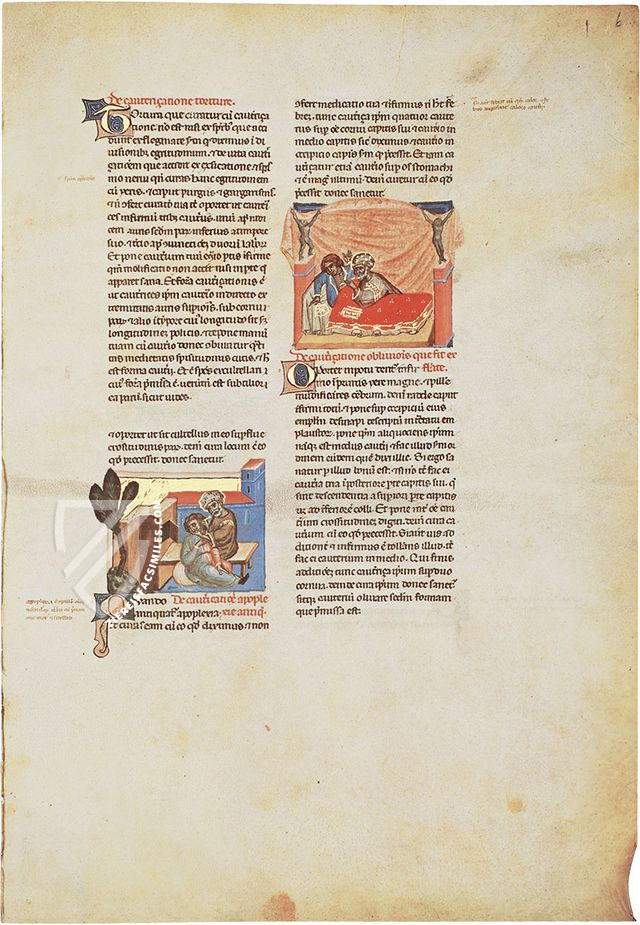
#1 Abu´l Qasim Halaf ibn Abbas al-Zahraui - Chirurgia
Language: German
The comprehensive scholarly commentary was written by Eva Irblich and comprises an introduction on the author and the translator of the manuscript as well as a description of the codicology and contents of the codex. The commentary volume is complete with a bibliography and an index on the contents of the manuscript.
(1,000€ - 3,000€)
#2 La Cirugía
Language: Spanish
The comprehensive scholarly commentary was written by Eva Irblich and comprises an introduction on the author and the translator of the manuscript as well as a description of the codicology and contents of the codex. The commentary volume is complete with a bibliography and an index on the contents of the manuscript.
- Treatises / Secular Books
- Apocalypses / Beatus
- Astronomy / Astrology
- Bestiaries
- Bibles / Gospels
- Chronicles / History / Law
- Geography / Maps
- Saints' Lives
- Islam / Oriental
- Judaism / Hebrew
- Single Leaf Collections
- Leonardo da Vinci
- Literature / Poetry
- Liturgical Manuscripts
- Medicine / Botany / Alchemy
- Music
- Mythology / Prophecies
- Psalters
- Other Religious Books
- Games / Hunting
- Private Devotion Books
- Other Genres
- Afghanistan
- Armenia
- Austria
- Belgium
- Belize
- Bosnia and Herzegovina
- China
- Colombia
- Costa Rica
- Croatia
- Cyprus
- Czech Republic
- Denmark
- Egypt
- El Salvador
- Ethiopia
- France
- Germany
- Greece
- Guatemala
- Honduras
- Hungary
- India
- Iran
- Iraq
- Israel
- Italy
- Japan
- Jordan
- Kazakhstan
- Kyrgyzstan
- Lebanon
- Liechtenstein
- Luxembourg
- Mexico
- Morocco
- Netherlands
- Palestine
- Panama
- Peru
- Poland
- Portugal
- Romania
- Russia
- Serbia
- Spain
- Sri Lanka
- Sweden
- Switzerland
- Syria
- Tajikistan
- Turkey
- Turkmenistan
- Ukraine
- United Kingdom
- United States
- Uzbekistan
- Vatican City
- A. Oosthoek, van Holkema & Warendorf
- Aboca Museum
- Ajuntament de Valencia
- Akademie Verlag
- Akademische Druck- u. Verlagsanstalt (ADEVA)
- Aldo Ausilio Editore - Bottega d’Erasmo
- Alecto Historical Editions
- Alkuin Verlag
- Almqvist & Wiksell
- Amilcare Pizzi
- Andreas & Andreas Verlagsbuchhandlung
- Archa 90
- Archiv Verlag
- Archivi Edizioni
- Arnold Verlag
- ARS
- Ars Magna
- ArtCodex
- AyN Ediciones
- Azimuth Editions
- Badenia Verlag
- Bärenreiter-Verlag
- Belser Verlag
- Belser Verlag / WK Wertkontor
- Benziger Verlag
- Bernardinum Wydawnictwo
- BiblioGemma
- Biblioteca Apostolica Vaticana (Vaticanstadt, Vaticanstadt)
- Bibliotheca Palatina Faksimile Verlag
- Bibliotheca Rara
- Boydell & Brewer
- Bramante Edizioni
- Bredius Genootschap
- Brepols Publishers
- British Library
- C. Weckesser
- Caixa Catalunya
- Canesi
- CAPSA, Ars Scriptoria
- Caratzas Brothers, Publishers
- Carus Verlag
- Casamassima Libri
- Centrum Cartographie Verlag GmbH
- Chavane Verlag
- Christian Brandstätter Verlag
- Circulo Cientifico
- Club Bibliófilo Versol
- Club du Livre
- CM Editores
- Collegium Graphicum
- Collezione Apocrifa Da Vinci
- Comissão Nacional para as Comemorações dos Descobrimentos Portugueses
- Coron Verlag
- Corvina
- CTHS
- D. S. Brewer
- Damon
- De Agostini/UTET
- De Nederlandsche Boekhandel
- De Schutter
- Deuschle & Stemmle
- Deutscher Verlag für Kunstwissenschaft
- DIAMM
- Droz
- E. Schreiber Graphische Kunstanstalten
- Ediciones Boreal
- Ediciones Grial
- Ediclube
- Edições Inapa
- Edilan
- Editalia
- Edition Deuschle
- Edition Georg Popp
- Edition Leipzig
- Edition Libri Illustri
- Editiones Reales Sitios S. L.
- Éditions de l'Oiseau Lyre
- Editions Medicina Rara
- Editorial Casariego
- Editorial Mintzoa
- Editrice Antenore
- Editrice Velar
- Edizioni Edison
- Egeria, S.L.
- Eikon Editores
- Electa
- Emery Walker Limited
- Enciclopèdia Catalana
- Eos-Verlag
- Ephesus Publishing
- Ernst Battenberg
- Eugrammia Press
- Extraordinary Editions
- Fackelverlag
- Facsimila Art & Edition
- Facsimile Editions Ltd.
- Facsimilia Art & Edition Ebert KG
- Faksimile Verlag
- Feuermann Verlag
- Folger Shakespeare Library
- Franco Cosimo Panini Editore
- Friedrich Wittig Verlag
- Fundación Hullera Vasco-Leonesa
- G. Braziller
- Gabriele Mazzotta Editore
- Gebr. Mann Verlag
- Gesellschaft für graphische Industrie
- Getty Research Institute
- Giovanni Domenico de Rossi
- Giunti Editore
- Graffiti
- Grafica European Center of Fine Arts
- Guido Pressler
- Guillermo Blazquez
- Gustav Kiepenheuer
- H. N. Abrams
- Harrassowitz
- Harvard University Press
- Helikon
- Hendrickson Publishers
- Henning Oppermann
- Herder Verlag
- Hes & De Graaf Publishers
- Hoepli
- Holbein-Verlag
- Houghton Library
- Hugo Schmidt Verlag
- Idion Verlag
- Il Bulino, edizioni d'arte
- ILte
- Imago
- Insel Verlag
- Insel-Verlag Anton Kippenberger
- Instituto de Estudios Altoaragoneses
- Instituto Nacional de Antropología e Historia
- Introligatornia Budnik Jerzy
- Istituto dell'Enciclopedia Italiana - Treccani
- Istituto Ellenico di Studi Bizantini e Postbizantini
- Istituto Geografico De Agostini
- Istituto Poligrafico e Zecca dello Stato
- Italarte Art Establishments
- Jan Thorbecke Verlag
- Johnson Reprint Corporation
- Josef Stocker
- Josef Stocker-Schmid
- Jugoslavija
- Karl W. Hiersemann
- Kasper Straube
- Kaydeda Ediciones
- Kindler Verlag / Coron Verlag
- Kodansha International Ltd.
- Konrad Kölbl Verlag
- Kurt Wolff Verlag
- La Liberia dello Stato
- La Linea Editrice
- La Meta Editore
- Lambert Schneider
- Landeskreditbank Baden-Württemberg
- Leo S. Olschki
- Les Incunables
- Liber Artis
- Library of Congress
- Libreria Musicale Italiana
- Lichtdruck
- Lito Immagine Editore
- Lumen Artis
- Lund Humphries
- M. Moleiro Editor
- Maison des Sciences de l'homme et de la société de Poitiers
- Manuscriptum
- Martinus Nijhoff
- Maruzen-Yushodo Co. Ltd.
- MASA
- Massada Publishers
- McGraw-Hill
- Metropolitan Museum of Art
- Militos
- Millennium Liber
- Müller & Schindler
- Nahar - Stavit
- Nahar and Steimatzky
- National Library of Wales
- Neri Pozza
- Nova Charta
- Oceanum Verlag
- Odeon
- Orbis Mediaevalis
- Orbis Pictus
- Österreichische Staatsdruckerei
- Oxford University Press
- Pageant Books
- Parzellers Buchverlag
- Patrimonio Ediciones
- Pattloch Verlag
- PIAF
- Pieper Verlag
- Plon-Nourrit et cie
- Poligrafiche Bolis
- Presses Universitaires de Strasbourg
- Prestel Verlag
- Princeton University Press
- Prisma Verlag
- Priuli & Verlucca, editori
- Pro Sport Verlag
- Propyläen Verlag
- Pytheas Books
- Quaternio Verlag Luzern
- Reales Sitios
- Recht-Verlag
- Reichert Verlag
- Reichsdruckerei
- Reprint Verlag
- Riehn & Reusch
- Roberto Vattori Editore
- Rosenkilde and Bagger
- Roxburghe Club
- Salerno Editrice
- Saltellus Press
- Sandoz
- Sarajevo Svjetlost
- Schöck ArtPrint Kft.
- Schulsinger Brothers
- Scolar Press
- Scrinium
- Scripta Maneant
- Scriptorium
- Shazar
- Siloé, arte y bibliofilia
- SISMEL - Edizioni del Galluzzo
- Sociedad Mexicana de Antropología
- Société des Bibliophiles & Iconophiles de Belgique
- Soncin Publishing
- Sorli Ediciones
- Stainer and Bell
- Studer
- Styria Verlag
- Sumptibus Pragopress
- Szegedi Tudomànyegyetem
- Taberna Libraria
- Tarshish Books
- Taschen
- Tempus Libri
- Testimonio Compañía Editorial
- Thames and Hudson
- The Clear Vue Publishing Partnership Limited
- The Facsimile Codex
- The Folio Society
- The Marquess of Normanby
- The Richard III and Yorkist History Trust
- Tip.Le.Co
- TouchArt
- TREC Publishing House
- TRI Publishing Co.
- Trident Editore
- Tuliba Collection
- Typis Regiae Officinae Polygraphicae
- Union Verlag Berlin
- Universidad de Granada
- University of California Press
- University of Chicago Press
- Urs Graf
- Vallecchi
- Van Wijnen
- VCH, Acta Humaniora
- VDI Verlag
- VEB Deutscher Verlag für Musik
- Verlag Anton Pustet / Andreas Verlag
- Verlag Bibliophile Drucke Josef Stocker
- Verlag der Münchner Drucke
- Verlag für Regionalgeschichte
- Verlag Styria
- Vicent Garcia Editores
- W. Turnowski Ltd.
- W. Turnowsky
- Waanders Printers
- Wiener Mechitharisten-Congregation (Wien, Österreich)
- Wissenschaftliche Buchgesellschaft
- Wissenschaftliche Verlagsgesellschaft
- Wydawnictwo Dolnoslaskie
- Xuntanza Editorial
- Zakład Narodowy
- Zollikofer AG

